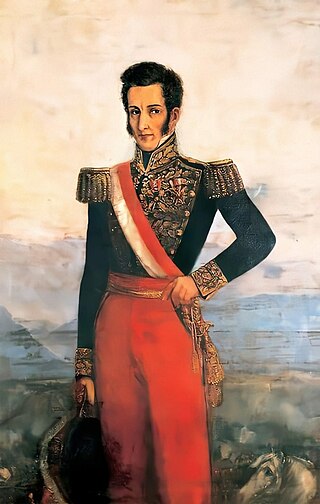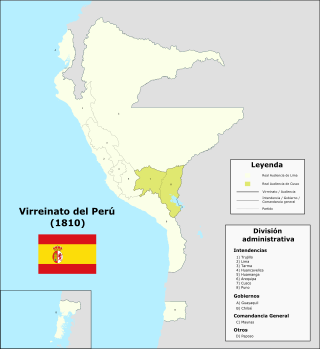
Moquegua is a department and region in southern Peru that extends from the coast to the highlands. Its capital is the city of Moquegua, which is among the main Peruvian cities for its high rates of GDP and national education.

José Domingo de la Merced de La Mar y Cortázar was a Peruvian military leader and politician who served as the third President of Peru.

The Battle of Maipú was fought near Santiago, Chile on 5 April 1818, between South American rebels and Spanish royalists, during the Chilean War of Independence. The Patriot rebels led by Argentine general José de San Martín effectively destroyed the Spanish forces commanded by General Mariano Osorio, and completed the independence of the core area of Chile from Spanish domination.

The Battle of Ayacucho was a decisive military encounter during the Peruvian War of Independence. This battle secured the independence of Peru and ensured independence for the rest of belligerent South American states. In Peru it is considered the end of the Spanish American wars of independence in this country, although the campaign of Antonio José de Sucre continued through 1825 in Upper Peru and the siege of the fortresses Chiloé and Callao eventually ended in 1826.

The Peruvian War of Independence was a series of military conflicts in Peru from 1809 to 1826 that resulted in the country's independence from the Spanish Empire. Part of the broader Spanish American wars of independence, it led to the dissolution of the Spanish Viceroyalty of Peru.
The Constituent Congress of Peru, 1822 was the first democratically elected institution in Peru. Its members, called deputies, were appointed by popular election called by the liberator José de San Martín, who then exercised power as Protector of Peru. The main task of this meeting was to give the Republic of Peru its first constitution, which was the liberal constitution of 1823. Also, before the retirement of San Martín, presented the Executive to three members, who formed a collegial body called the Supreme Governing Junta and whose head was General José de la Mar. subsequently ratified in succession to the former presidents of the Republic of Peru: José de la Riva Agüero and José Bernardo de Tagle.

Pedro Blanco Soto was a Bolivian soldier and politician and president of the Republic of Upper Peru, an unrecognized entity that emerged in the limits of the department of La Paz and, which claimed the territory of the Republic of Bolivia. He held the position for a short time before being killed by his opponents in a convent called La Recoletta in Sucre on New Year's Day 1829. A small plaque now marks the spot in the Museo de la Recoletta. He was well known for his pro-Peruvian stance and this is generally the reason attributed to his assassination. He was also a distinguished officer during the Peruvian War of Independence.

The Battle of Tucumán was fought on 24 and 25 September 1812 near the Argentine city of San Miguel de Tucumán, during the Argentine War of Independence. The Army of the North, commanded by General Manuel Belgrano, defeated the royalist troops commanded by General Pío de Tristán, who had a two-to-one advantage in numbers, halting the royalist advance on Argentina's northwest. Together with the Battle of Salta, on 20 February 1813, the victory at Tucumán allowed the Argentine troops to reaffirm the borders under their control.

Bolivia's independence was definitively proclaimed on 6 August 1825 at a congress held in Chuquisaca.

The Protectorate of Peru, also known as the Protectorate of San Martín, was a protectorate created in 1821 in present-day Peru after its declaration of independence from the Spanish Empire. The protectorate existed for one year and 17 days under the rule of José de San Martín and Argentina.
The Cuzco Rebellion of 1814 was an episode of the Peruvian War of Independence led by the Angulo brothers and Mateo Pumacahua that took place in much of the province of Cuzco, including Huamanga, Arequipa and Puno, as well as part of the province of Charcas. The uprising involved the proclamation of the autonomy and self-government of Cuzco from the Viceroyalty of Peru, governed by Viceroy José Fernando de Abascal y Sousa. The junta was modelled and intended to follow the steps of the Junta of Buenos Aires.

Osmore River system flows northeast to southwest in the Moquegua Region of southern coastal Peru. The river has its origin in the snow peaks of the Chuqi Ananta and Arundane mountains, at an elevation of 5,100 metres (16,700 ft) above sea level. It changes names as it descends from the Andes: From its origin it is called the Moquegua, then Osmore in the middle valley as Rio Coscori and Rio Tumilaca including where the river disappears into subterranean channels, and further down in the lower reaches as Rio Ilo.

The Peruvian Civil War of 1843–1844 was the second internal conflict in 19th century Peru. It was fought between the government forces of Vivanco and Echenique against the revolutionaries led by Domingo Nieto and Ramon Castilla. A battle was fought at Pachia in Tacna on August 29, 1843. A clash occurred at San Antonio, Moquegua on October 27, 1843. Domingo Nieto died on February 17, 1844. From June 17 to June 29, 1844, fighting occurred in the capital Lima between the government and supporters of Domingo Elías. A final clash occurred at Carmen Alto on July 22, 1844.

The history of Peru between 1821 and 1842 is the period considered by the country's official historiography as the first stage of its republican history, formally receiving the name of Foundational Period of the Republic by historian Jorge Basadre. During this era, what became known as the First Militarism, a period where several military figures held control of the country, started in 1827 with José de La Mar's presidency, ending in 1844.

The First Intermedios campaign, also known as the 1822 campaign of the Intermedios ports, was a military expedition led by General Rudecindo Alvarado on behalf of the Peruvian Congress against the royalist forces stationed in the southern mountains of Peru.

The Battle of Moquegua took place during the Peruvian War of Independence on 21 January 1823 around the city of Moquegua, between the Liberation Army of Peru, under command of Argentinean General Rudecindo Alvarado, and the Royal Army of Peru under General José de Canterac. The army of the Patriots was almost completely destroyed.

Campaigns of the South is the name given to a series of military campaigns that Greater Colombia launched between 1820 and 1826 in South America with the purpose of expanding over the territories of the current republics of Colombia and Ecuador, as well as consolidating the independence of the republics of Peru and Bolivia. This was an extension of the multifaceted civil war launched against the Royalist Army in the Americas, which sustained the integrity of the Spanish Empire in such territories. Beyond the surrender of the regular armies, the royalist guerrillas in each country fought for several more years.

The Second Intermedios Campaign was a phase of the Independence of Peru that occurred between May and October 1823. Returning to the plan of the First Intermedios campaign, the Peruvian Army, under the command of General Andrés de Santa Cruz, landed in the so-called "intermediate ports" of southern Peru and entered into Upper Peru, a region dominated by royalist forces under the command of viceroy José de la Serna. After the indecisive battle of Zepita and a campaign described as "no better than the first," the patriots were overwhelmed by the massive royalist attack and retreated to the coast, with the survivors barely managing to embark.

The Supreme Governing Junta, also known as the Supreme Governing Junta of Peru, was the military junta that governed Peru as the country's executive power after José de San Martín renounced his title of Protector of Peru in September of 1822. It was created on July 20, 1822, by the country's Constituent Congress.

The Intendancy of Arequipa, also known informally as Arequipa Province, was one of the territorial divisions of the Viceroyalty of Peru, ruled from the city of Arequipa and under the jurisdiction of the Bishopric of Arequipa. It existed from 1784 to 1824, receiving the news of the result of the Battle of Ayacucho in late December of the same year.















